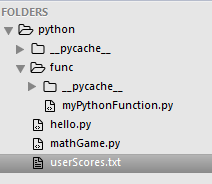python实现用户答题功能
python实战,用户答题分享给大家。
主要包含内容,文件的读取,更改,保存。不同文件夹引入模块。输入,输出操作。随机获取数据操作
随机生成算数表达式,用户输入答案,正确记录分数,错误返回0,并把用户分数记录到文本文件中,如用户名不存在着新建用户
myPythonFunction.py包含三个函数
#coding=utf-8
from random import randint
from os import remove,rename
#function 输入用户名字,获得用户得分,返回得分或者-1
def getUserScore(userName):
try:
f = open("userScores.txt","r")
msg = f.readline()
score=-1;
while len(msg):
msg = msg.strip('\n')
msgArr = msg.split(",")
if(msgArr[0]==userName):
score = msgArr[1]
break
msg = f.readline()
f.close()
return score
except IOError:
f=open("userScores.txt","w")
f.close()
return -1
#function 更新或者保存用户名字,用户得分
def updateUserPoints(userName,score):
temp = getUserScore(userName)
if(temp==-1):
f = open("userScores.txt","a")
msg = userName+","+str(score)+"\n"
f.write(msg)
f.close()
else:
temp = open("userScores.tmp","w")
f = open("userScores.txt","r")
msg = f.readline()
while len(msg):
msg = msg.strip('\n')
msgArr = msg.split(",")
if(msgArr[0]==userName):
msgArr[1] = str(score)
temp.write(msgArr[0]+","+msgArr[1]+"\n")
msg = f.readline()
f.close()
temp.close()
remove("userScores.txt")
rename("userScores.tmp","userScores.txt")
#function 获取随机生成的数学表达式 ,返回字符串
def getQuestionString():
operandList = []
operatorList = []
operatorDict=("+","-","*","**")
questionString = ''
for i in range(5):
operandList.append(randint(1,9))
for j in range(4):
operatorList.append(operatorDict[randint(0,3)])
for k in range(4):
questionString += str(operandList[k])+operatorList[k]
questionString +=str(operandList[4])
return questionString
mathGame.py作为主函数
# -*- coding:utf-8 -*-
import sys
if 'H:\\python\func' not in sys.path:
sys.path.append('H:\\python\\func')
import myPythonFunction as myfunc
print("请输入你的名字:")
use = input()
use=use.strip("\n")
count = 0
if(myfunc.getUserScore(use)==-1):
print("你是个新用户!")
myfunc.updateUserPoints(use,0)
else:
count = int(myfunc.getUserScore(use))
print("你当前分数为:",count)
while(1):
questionString=myfunc.getQuestionString()
result = eval(questionString)
print("问题:",questionString.replace("**","^"))
print("请输入你的答案:")
userResult = input()
userResult = userResult.strip("\n")
flag = True
if(userResult.startswith("-")):
userResult = userResult[1:]
flag = False
while((not userResult.isdigit()) and userResult!="exit"):
print("请输入数字,你的答案:")
userResult = input()
userResult = userResult.strip("\n")
if(userResult.startswith("-")):
userResult = userResult[1:]
flag = False
if(not flag):
userResult = "-"+userResult
if(userResult==str(result)):
print(1)
count = count+1
elif("exit"==userResult):
break
else:
print(0)
myfunc.updateUserPoints(use,count)
print("你当前分数为:",count)
print("谢谢进入,欢迎下次再来!")

文件目录结构,将myPythonFunction.py放到func文件夹中。userScores.txt存放用户名和相应的得分

以上就是本文的全部内容,希望对大家的学习有所帮助,也希望大家多多支持【听图阁-专注于Python设计】。

